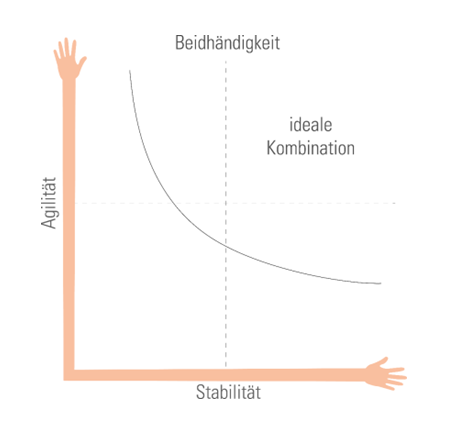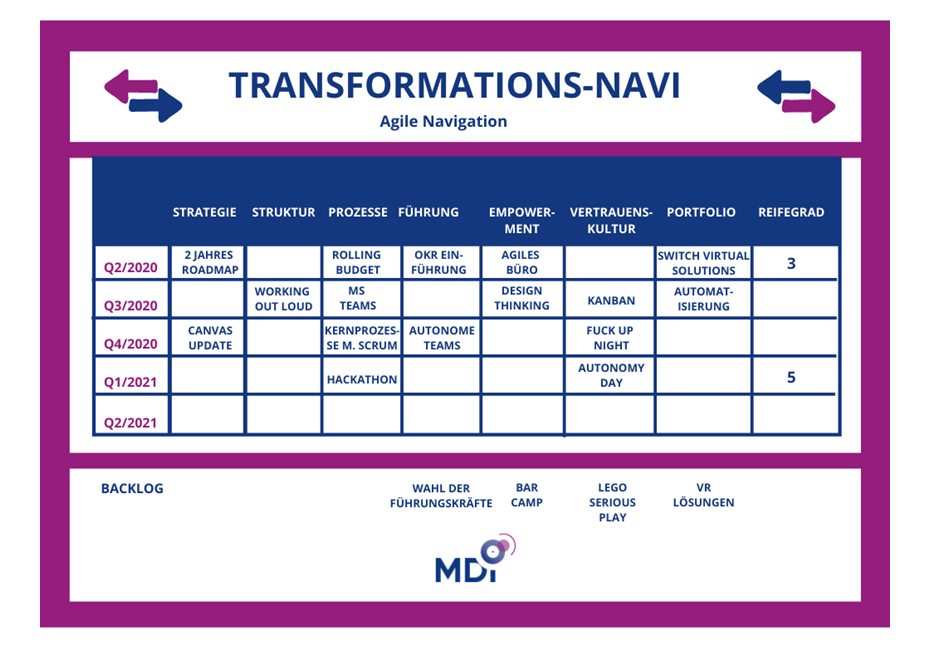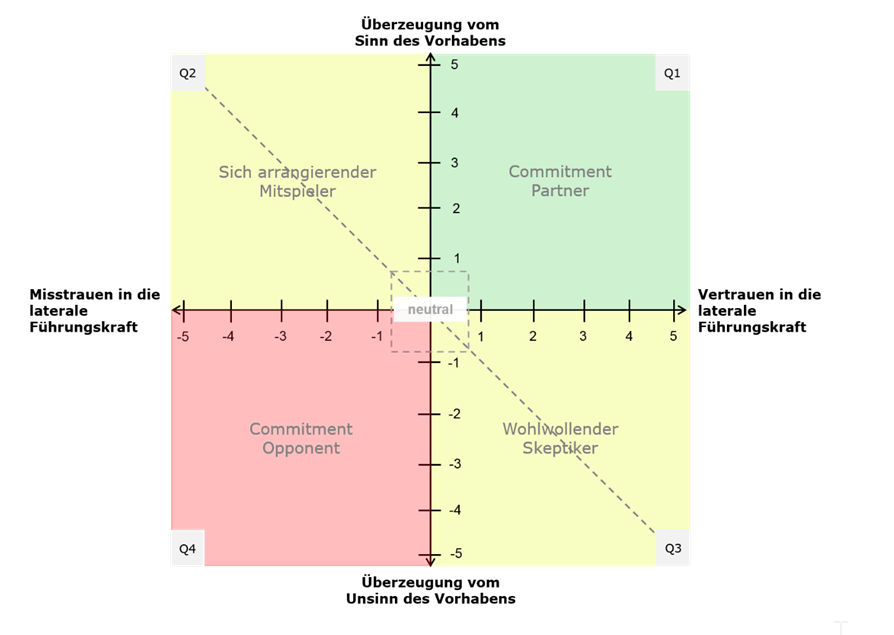
4 Agile Change Management Tools
Many businesses are currently reinventing themselves. Most companies have been undergoing massive changes since the beginning of 2020. Many of them are actively trying to shape the digital transformation.
In this blog post Anita Berger, Gunther Fürstberger and Masha Ibeschitz, share 4 agile change management tools that help to consciously initiate and manage change:

Anita Berger
Executive Coach, Consultant, Trainer & Managing Partner MDI
Anita Berger is an executive coach, consultant and trainer specialising in leadership development and international human resource management. She is a partner of MDI Management Development International. For more than 15 years she has worked in management and leadership positions (among others as HR-
Director at Coca-Cola Hellenic and HR Manager at Konica Minolta Business Solutions).

Gunther Fürstberger
CEO , MDI Management Development International
Gunther Fürstberger is a management trainer, book author and CEO of MDI, a global leadership development institute and managing director of Metaforum. His core competence is leadership in the digital transformation. He gained his own leadership experience as HR manager of McDonald’s Central Europe/Central Asia, among others.

Masha Ibeschitz
Founder and CEO , Think Beyond Group
As an executive coach, consultant, key speaker and reflection guide for top executives, the graduate in business administration is active worldwide and accompanies her international clients through the challenges of the “VUCA world”. Masha Ibeschitz is the founder and chairwoman of the Think Beyond Group and a shareholder of MDI. She is also the author of several non-fiction books (“Success Reloaded”, “Impact”)
4 Agile Change Management Tools
Organisations can use these four tools to reflect on the transformation so far and to set the next steps.
- Land/water metaphor
- TIE: Transparency, Iteration and Empowerment
- Transformation Navigation
- Stakeholder Commitment Analysis
1. land/water metaphor
In order to even decide whether agility is needed in a company or specific area, the “land/water metaphor” helps:
If you operate in a reasonably stable environment, you can build on solid ground and will be well served by a traditional management and leadership philosophy. Too agile methods would even irritate in such a company.
On the other hand, if you are exposed to one wave of disruption after another, you better learn to surf soon. This means that such a corporate unit must be constantly on the move in order to remain in balance.
Ambidextry – the art of ambidexterity – is essential for many organisations. They need both the ability to manage the present and the artistry to tap into the even more uncertain future opportunities. The answer to land and water is the right combination of stability and agility.
One hand represents the ability to establish a stable foundation. It is about introducing clear processes, not reinventing the wheel, establishing a system of key figures – in other words, a structure that you can stick to.
The other hand stands for the ability to drive change, to be attentive to the disruptive waves coming in, to select and ride the right ones. It is about speed, optimal adaptability, continuous interaction and proactivity.
Agile transformation does not mean that every business unit should be maximally agile.
Rather, it is the movement towards the ideal combination of agility and stability. For example, a retail company may realise that it can secure its own future by providing a combined shopping experience of online world and physical outlets, while the corporate culture evolves from “command and control” to a fruitful co-existence of agile and stable elements.
Covid lockdowns add to the need for companies to be able to switch quickly between different service offerings. Retailers need webshops and good distribution, but then they need their branches again. Seminar providers need to be able to switch from face-to-face to virtual and hybrid solutions within a few days.

2. TIE: Transparency, Iteration and Empowerment
Transformation, iteration and empowerment are the three main principles of agility that can be found in all agile tools. They are suitable for defining the ideal level of agility in a company’s culture from today’s point of view. What is considered “optimal” differs depending on the industry. In the financial sector, for example, there are justified restrictions regarding the transparency of information. Companies determine for themselves what they currently consider to be the ideal degree of transparency, iteration and empowerment. The following scale questions, for example, are suitable for this purpose:
- How would we recognise that we are living our ideal empowerment culture?
- How would our employees/customers/leaders measure this?
- How does it feel?
- How would employees and managers behave?
- What then differentiates us from other players in the market?
The answers come together to form a detailed goal picture – the vision of the transformation process. The shared vision is one of the most important motivational foundations needed to muster the necessary energy for change.
- On a scale of 1 to 10 (10 = optimal transparency, iteration, empowerment), where do we stand today? This is how we determine where we are.
- What is the difference between 1 and the chosen value? The answer is what is already working well and what can be built on.
- What would have to happen in which area of the company for us to move up one point?
- What specifically will we do next to move up one point? This is the start of the concrete action planning.
3. Transformation Navigation
The Transformation Navi (based on ideas from HR Pioneers and McKinsey) helps us navigate progress on our agility journey. It is a matrix whose horizontal axis represents the transformation areas and whose vertical axis represents progress over time.

Every company can decide to add or omit certain areas of transformation. It should not orient itself exclusively on its own sector. Perhaps the company currently sells products such as training and in the future will mainly offer software solutions that largely replace the previous products.
In the last column, the maturity level is entered. This results from the average of the answers to the previously described position-finding questions: On a scale of 1 to 10 (10 = optimal transparency, iteration, empowerment), where do we stand today?
In terms of transparency, organisations should make the transformation navi visible to all employees. At least once a quarter, a team representative of the business units meets to look back at what has been achieved and define what will be tackled in the coming quarter.
A well thought-out and lived KPI system ensures that the continuous measurement of progress is based on an objective and stable foundation. This KPI system mostly includes metrics related to financial, customer and employee satisfaction, productivity and innovation and, in addition to the intended agility, contributes above all to stability.
4. Stakeholder Commitment Analysis
Not everyone is always convinced that change is needed. Transformation is often met with active or passive resistance. The stakeholder commitment analysis serves to get a picture of the overall situation. Agile transformation is often not imposed from above, but driven by leaders and employees at different levels. Therefore, the ability to gain commitment is needed as a lateral leader. So if you want to drive transformation, you can put yourself and the key stakeholders on the chart.

Commitment is made up of two components: We are convinced of the sense of the project and we trust the person who wants change. If we place the different stakeholders in the four fields of the diagram, it quickly becomes clear whether the majority supports the change or rather wants to prevent it. The dashed diagonal line marks the equilibrium line. Whether the entire field tilts to the lower left towards resistance or to the upper right towards commitment at the moment of analysis also depends on the weight that the individual stakeholders or stakeholder groups bring to the table based on their positional authority, expertise and personality strength.
Based on this positional analysis, you can now take accurate steps to increase the commitment of the stakeholders. There are many ways to do this, such as holding conversations to build trust, understand interests, explain your own intention and work together to find solutions that optimise the collective benefit of all those affected by the transformation. However, it may also be useful to recruit new stakeholders who support the change and already have relevant experience. If a high level of resistance to change has been cemented in, it may ultimately be necessary to work on getting preventers to leave the field. But in most cases, a clear analysis of the situation and convincing and empathetic dialogue lead to good results.





